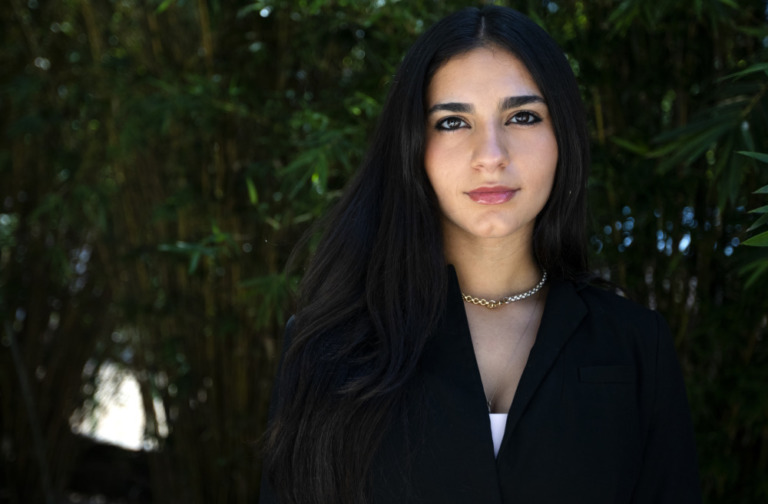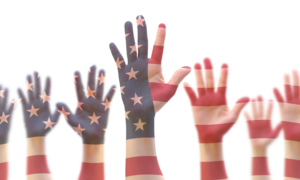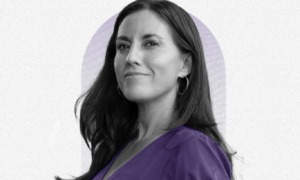Tallahassee, Florida – Seven months after Nadya Rexach-Rivera celebrated her quinceañera in her beloved Puerto Rico, Hurricane Maria upended her life. The catastrophic storm in 2017 left the island without water, power and any semblance of normalcy. She and her family survived and now, five years later in Florida, Rexach-Rivera is doing her part to help others weather hurricanes.
 And she is doing it with a passion to save the planet.
And she is doing it with a passion to save the planet.
This summer, 25 sustainably made hurricane survival kits designed by a team at Florida State University, including Rexach-Rivera, will be available for people to check out at libraries across the Panhandle.
The kit’s reusable items include a solar light, a water bottle with a mini filtration system, bandanas that double as area-specific evacuation route maps, waterproof pouches for protecting documents and mobile phones and a multi-use tarp that can be used as a stretcher or flotation device as well as signaling to rescue units. And there is a cloud-shaped hand soother designed to relieve stress during disaster. All of it comes packed in a recycled 600-denier polyester backpack.
“We are starting out small in Florida, but exponentially, it could have a very significant impact,” Rexach-Rivera said. “We would love to grow this as far as we can and then cross the ocean to Puerto Rico. It’s very cool.”
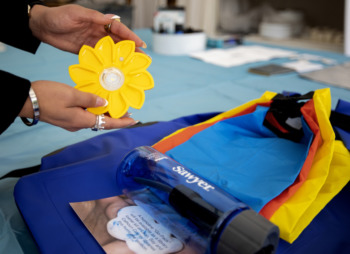
Chasity Maynard/Youth Today
Nadya Rexach-Rivera holds a solar lantern, part of the hurricane “Go-Pack.”
She said she felt compelled to act. As a survivor of a major hurricane. As a teenage woman facing a future dampened by dire climate predictions.
She hails from a generation that is destined to see climate extremes. Earth’s temperature is rising and carbon dioxide has hit record levels in the atmosphere. The seas are swelling as the ice caps melt and storms are more frequent and furious.
These are grave concerns for Rexach-Rivera and her fellow Gen Zers. She admires Greta Thunberg, the Swedish activist who is her age.
“Who is the face of activism for the environment? A young girl,” Rexach-Rivera said, adding that it took someone from Gen Z to challenge global leaders to take action on climate change mitigation.
“We are taking a stance,” she said.
Holly Henassian, the Florida State fine arts professor who conceived of the kits and recruited Rexach-Rivera, said she was drawn to work with young people because of their positive outlook and desire to work toward tangible change, even amid such bleak predictions for the future.
“People who are under 30 understand the dire consequences of climate change,” Hanessian said.
Rexach-Rivera said she engages in small acts every day that all add up in the end. She recycles all her plastic and makes sure to turn off lights get turned off when not in use.
“This project has made me conscious of the environment and where we are going,” Rexach-Rivera said. “Me, as a 19-year-old, I try to do everything I can.”
‘Who created God?’
Rexach-Rivera grew up in San Juan, the eldest of three siblings. As a young girl, she wore clothes that matched her American Girl doll and dreamed of becoming a super model scientist. She was just as fascinated with feather boas and stilettos as she was with the rivers of lava that erupted from volcanoes. Later, she developed a love of running, became captain of her school’s track-and-field team and made it all the way to the Junior Olympics.
Her father, Augstin Rexach, described his daughter as “an adult in a child’s body.” She was curious and asked a thousand questions. “Dad, if God was the creator of the world, the universe, then who created God?” she asked. “It doesn’t make sense to me.”
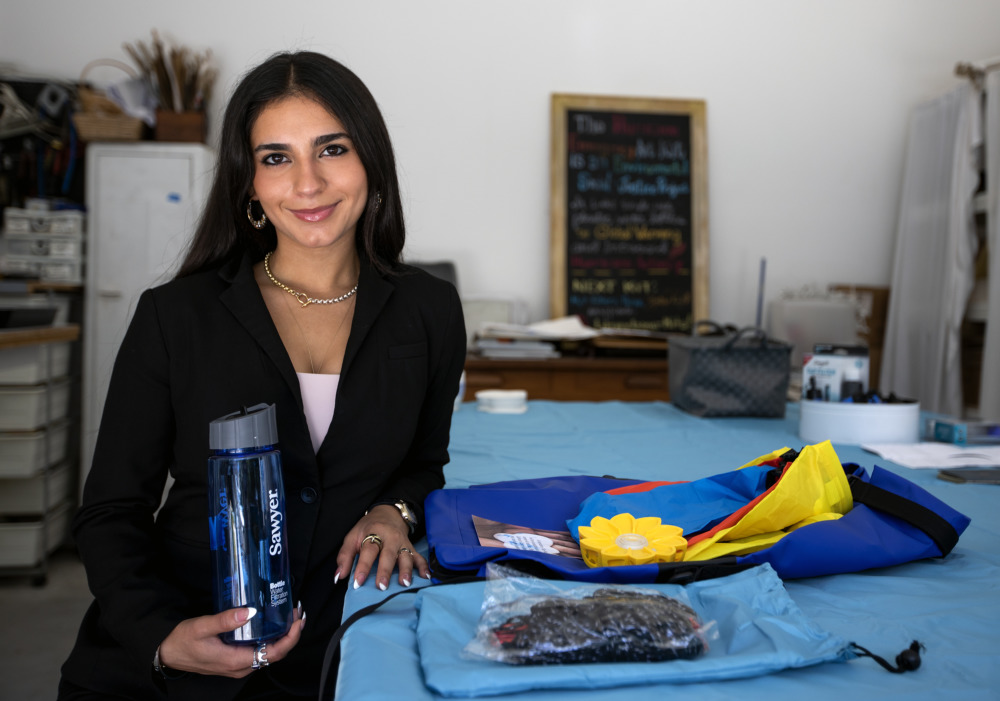
Chasity Maynard/Youth Today
Nadya Rexach-Rivera holds a Sawyer bottle water filtration system, part of the hurricane “Go-Pack” beside her in her mentor Holly Hanessian’s studio in Tallahassee, Florida on Saturday, April 23, 2022.
Rexach built from scratch a construction business in Puerto Rico and by his own admission, he did well for his family. They lived in a prosperous neighborhood, in a house with a swimming pool high atop a hill, which turned out to be lifesaving in September of 2017, when Irma and then Maria pummeled the island in quick succession, drowning low-lying areas.
Through the many windows on their home’s ground floor, Rexach-Rivera could see Maria approaching. The skies turned dark and foreboding. Then, the storm came ashore with winds as high as 150 miles per hour, pounding Puerto Rico for what seemed an eternity.
Rexach-Rivera huddled with her family on the second floor for 12 terrifying hours. She heard the explosions of electrical poles and chunks of roofs and concrete hurtling through the air as though they weighed nothing. The family trampoline flew away like a giant bird.
Even in the darkness, she could sense the water rising in San Juan. One of her father’s trucks was four feet underwater. At one point, he went outside to clear the gutters. That was when she really got scared; she was afraid he would not be able to come back inside.
In the days after the wind and rain finally stopped, more than 3 million Puerto Ricans found themselves without electricity. Many struggled to find drinking water, food and gasoline.
“We were allowed one bag of rice, one can of beans,” Rexach-Rivera said about the rationing at grocery stores. “Food was scarce. We paid $80 for a tank of gas to fuel our generator.”
The human toll and utter destruction were difficult to fathom, but Rexach-Rivera recognizes she was fortunate. Her family was well off; they still had a roof over their heads and were able to eat. But it was obvious that life as they knew it would not return to Puerto Rico for a very long time.
As the island struggled to claw its way out of the destruction, Rexach-Rivera fled with her family to Florida to start life anew in October 2017. But she could not jettison the storms from her head.
Survival and sustainability
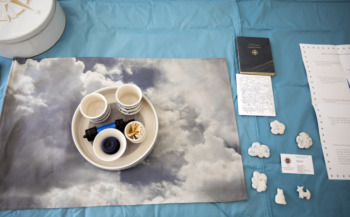
Chasity Maynard/Youth Today
A hurricane survival kit prototype supplies including self soothers, a Sawyer mini water filter, cups and matches. The kit is designed to be comforting, including items like a candle, coloring book and tableware.
Rexach-Rivera started classes at FSU in the fall semester of 2021, when colleges were still reeling from another sort of disaster — the COVID-19 pandemic. She quickly became known to her friends and classmates as the short woman with the long flowing hair who whizzed through Landis Green on her skateboard. She had developed a love of skateboarding after her family settled in Delray Beach and her new friends taught her how to wave surf. She loved it so much that she took up skateboarding.
Sometimes, she likes to lie on a hammock and listen to reggaeton tunes. One of her favorite artists is rapper Bad Bunny, a grocery bagger who catapulted to stardom in his mid-20s. His latest album, “Yo Hago Lo Que Me Da La Gana” translates to: I do what I want.
“His story attracts me to him as much as his music,” Rexach-Rivera said.
At FSU, she joined Zeta Tau Alpha as a way to get involved with the community. Beyond the philanthropic activities, she says she liked the fact that everyone in the sorority took on leadership positions. She says the sorority has been empowering and given her a sense of home away from home.
Rexach-Rivera spent her last summer before college combing through a database of more than 800 projects ranging from the Big Bang to art therapy in prisons. She had been asked to choose five in her application for an undergraduate research program.
She was young but perhaps wiser than her years. She already knew she would major in STEM Entrepreneurship; she aspired to becoming a successful business owner, like her father. One particular project, led by Hanessian, caught her eye.
The professor was unlike herself; they were polar opposites, really. Hanessian called herself an artist who worked at the “fringes of craft and social practice.” She was a skilled ceramicist and taught in Florida State University’s fine art department. She hoped to create a small but sustainable kit designed to help ease both mind and matter amid a monster storm. And she needed help from a bilingual student who could produce Spanish language kits and was proficient in the Adobe suite of computer programs.
Related Stories
• After a win for U.S. climate change education, classroom implementation is off to a slow start
• Youth find hope restoring Rio Grande wetlands threatened by climate change
• Latino activism leads in grassroot efforts on climate change
• Youth and climate change: How a generation is adapting while fighting for their future
Rexach-Rivera checked the boxes but it was more than that; the project’s appeal was deeply personal. She knew firsthand what it was like to survive the force of nature. And how important it was to be prepared. As a high school student, she had participated in a New York Times summer program on entrepreneurship and fashion. The student projects, focused on fair labor practices and sustainability, left an indelible mark. She no longer buys fast fashion.
She knew her knack for entrepreneurial adventure would fit in well with what Hanessian hoped to achieve with her sustainable hurricane kit project. If the art professor was the creative mind behind this important project, then Rexach-Rivera would step in as the practical one who made it happen.
Alex Mayer, director of the Center of Environmental Resource Management at the University of Texas in El Paso, said there are multiple reasons the Rio Grande is drying up. He has spent his career researching water management and has worked on many projects dealing with water scarcity, human infrastructure, and climate change.
“I thought she would be good for this because she had gone through Maria,” Hanessian said.
The hurricane kit project began in 2018, just before Hurricane Michael slammed into the Florida Panhandle. Hanessian noticed the mountains of single-use plastic water bottles being sold at the front of her local Walmart store.
“Oh, that made me so angry,” she recalled.
The non-profit Container Recycling Institute estimates that Americans bought more than 70 billion plastic water bottles of one gallon or less in 2018. Plastic bottles consume an enormous amount of fossil fuels to produce and three out of four end up in a landfill or incinerator. Millions more littered roads, beaches, rivers and other waterways.
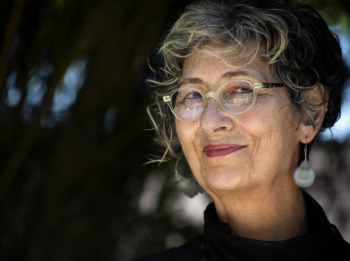
Chasity Maynard/Youth Today
Holly Hanessian pose for a portrait outside her home in Tallahassee, Florida on Saturday, April 23, 2022.
Hanessian saw people hoarding water bottles, especially ahead of a natural disaster.
She also saw that in the back of the same Walmart, in the camping equipment aisle, the store sold mini water filters manufactured by Sawyer International that sold for under $40.
She contacted Sawyer and partnered with it as well as Little Sun, a renewable energy organization that launched in 2012 with the intention of providing solar-powered lighting to people without electricity in Ethiopia.
“I wanted to know from Nadya what her experience was like through Irma and Maria,” Hanessian said. “After Hurricane Maria, [her family] did not have electricity for three months. She used part of her story when we approached Little Sun.”
Rexach-Rivera said she wishes her family could have availed themselves of a hurricane kit like the one she developed. Instead, she remembers her family was forced to collect rain for bathing and buy plastic water bottles for drinking. Her mother lit a candle every night for light in the weeks of darkness.
“The government was failing to reach people in survival mode,” she said.
The water bottle especially impressed Rexach-Rivera.
“That little thing can filter 100,000 gallons of water,” she said. “That was eye-opening.”
She interviewed her own family members and surveyed others about their experiences enduring a hurricane. And she coordinated with experts at Resilient Infrastructure and Disaster Response (RIDER Center), a joint initiative between Florida State and Florida A&M universities that “promotes all-inclusive and equitable disaster resilience for vulnerable populations.”
RIDER has been working on increasing the use of public libraries – accessible to people from all walks of life — as relief hubs during disaster. So, along with the keyboards, pressure washers and Go Pro cameras, the FSU team’s hurricane kits will be barcoded and soon be available for checkout by community members.
The hurricane kit is not just a survival tool but is designed to promote climate awareness, help people connect and ease anxiety about the future. Thus, the cloud-shaped hand soother.
Leon County librarian and researcher Savannah Cole, 26, played a major role in getting the first batch of hurricane kits to libraries.
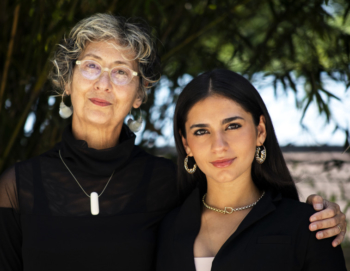
Chasity Maynard/Youth Today
Nadya Rexach-Rivera and her mentor Holly Hanessian pose for a portrait outside Hanessian’s house in Tallahassee, Florida on Saturday, April 23, 2022.
“It is designed to give communities with very little resources, a chance at making it through the storm,” said Cole, the librarian. “If this kit helps one person, one family, feel confident in their ability to make it through the storm and after, then this kit will be a success to me.
“If we all decided to change minor parts of our lives, our collective impact could actually make a difference,” she added.
Hanassian’s project is still in its initial stages, although she hopes to secure funding that might help these kits make their way into many more libraries, not just in Florida but in Puerto Rico as well.
Rexach-Rivera’s father says the kits could be lifesaving for people who live in remote areas. That they are sustainable makes them lifesaving for the planet.
Meanwhile, Rexach-Rivera is planning to earn a Ph.D. and one day open a company of her own in South Florida. A business that will put to use her energy and also her computer science skills.
At 19, Rexach-Rivera still has a couple of decades to fulfill her “to do” list. But two things are certain: That she will always see herself first as a proud Puerto Rican, and that the storms that blew her to this juncture have forever changed the ways she views the environment.
If everyone would just do their small part, she says, her children might still be able to enjoy this planet. They might still be able to live in her dream house in South Florida, off A1A, the highway that hugs the Atlantic coast of Florida, without large swaths of land at risk of being forever submerged.
***
Veteran journalist Moni Basu is the Michael and Linda Connelly Lecturer in Narrative Nonfiction at the University of Florida.
Chasity Maynard is a photojournalist at the Tallahassee Democrat. This year, she was a Hearst Photojournalism Championship Finalist and the winner of the Society of Professional Journalists Feature Photography Mark of Excellence for her region.


